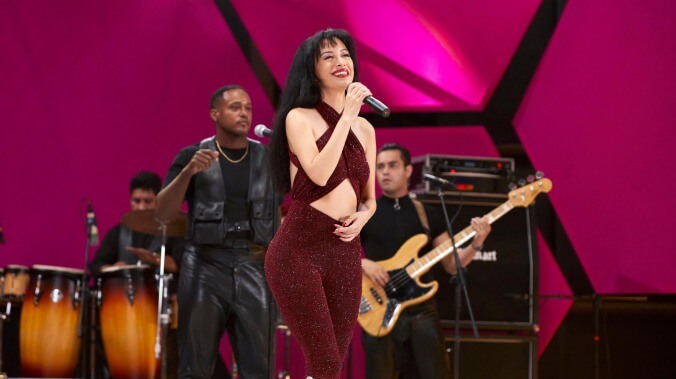Selena: The Series finally puts the singer in the spotlight, but it’s not nearly enough


The first nine episodes of Netflix’s Selena: The Series handled the life of the Queen Of Tejano with a lot of heavy-handed sentiment but nowhere near as much nuance. With the late singer’s father Abraham Quintanilla and sister Suzette Quintanilla serving as executive producers, the first half of the series dug deep into the lives of the different family members as Selena y Los Dinos rose to stardom, and it wasn’t until the last few episodes that it began to focus on the singer herself. Part Two of Selena: The Series picks up where Part One left off, and attempts to give viewers a closer look at her experiences and conflicted feelings as she became more famous and got closer to recording her first English album. While the singer does get more of the spotlight in Part Two, she’s still singing backup to the rest of her siblings in what remains more of a family drama than a revealing biopic series.
Desperately craving the love she’s been singing about, Selena continues to see Chris Perez (Jesse Perez) despite her family’s disapproval. She also becomes more vocal about things she dislikes and the things she wants as she further establishes herself as a singer-songwriter, fashion designer, and business owner—a huge departure from Part One, which showed her as the submissive and “perfect” daughter who went along with everything her father said. And as Selena comes into her own, so, too, does lead actor Christian Serratos. Though it still feels (and sounds) like she’s doing an impression of Jennifer Lopez as Selena, there are quite a few moments beyond the stage where she is able to shed those similarities and offer her own take on the singer. This is especially vivid in scenes where Selena y Los Dinos are hanging out in their tour bus or home, or when they’re recording hits like “Techno Cumbia,’’ and Serratos allows the rhythm of the music to move her. Here, the fashion and makeup feel truer to Selena’s iconic albeit eccentric style in these episodes, which lessens the parody feel that dominated the first half of the series.
Yet, despite Serrato’s best attempts to capture Selena’s many emotions while balancing her growing stardom, business obligations, and family, it remains clear that any expansion of these feelings is still mired in the Quintanilla family’s control. Like Part One, Part Two is made up of nine episodes, limiting how much of the storyline can actually be about just Selena. Though the time jumps are less frequent this time around, the show continues to oscillate between her two siblings, Suzette (Noemí González) and A.B. (Gabriel Chavarria), further fleshing out their story arcs and the contributions they made to Selena’s career. Whenever the story seems like it’s going to probe deeper into Selena’s psyche, here comes a scene about A.B. struggling to write a song. While it can be enjoyable to learn more about Los Dinos and their creative processes—certainly, seeing how Selena’s hits came to life is rather amusing—the Quintanillas and showrunners Moisés Zamora and Jaime Dávila have yet to deliver more than what is already known about Selena from her biopic and biographies.
These limitations can, in part, be attribute to the fact that Selena is not around to expand on her journey or the issues she faced growing up in the spotlight, or more notably, the intricacies that come with being a young, married woman. But even where there is opportunity to explore these feelings—like when she fears she has to put her life on hold for tours, or she and Chris experience jealousy or marital problems—the series refuses to go beyond the surface and instead shifts the focus back to tracking her career milestones. Though a cultural icon, Selena was, after all, a human being, and it’s this that the series never seems to grasp for more than a few minutes.
The show has naturally been building toward Selena’s tragic and untimely death. Yolanda Saldivar (Natasha Perez) was briefly introduced in the first half of the show when Selena’s fan club was being set up. In Part Two, she is given more screentime, as she helps with the Selena Etc. boutique and slowly becomes one of the Quintanilla family’s most trusted friends and confidants. Perez plays her with a quiet perseverance; every scene involving Yolanda immediately feels tenser, which demonstrates how her involvement with Selena bordered on obsession from the beginning. When she calls Selena to help run the boutique, Yolanda lights a candle to place on her Selena shrine as a dramatic score ascends in the background.
Nonetheless, the series doesn’t dwell too much on her because it doesn’t need to—it’s well known what Saldivar did, and any additional focus on her would have wasted the opportunity to expand on Selena’s final months, as she worked on her English album and performed her legendary show at the Houston Astrodome. But even these moments rely on viewer familiarity, rarely ever shedding new light on Selena’s life. In Selena: The Series Part Two, the story of the Queen Of Tejano is once again a narrow tale told through the lens of the rest of the Quintanilla family.